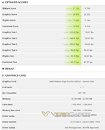- Joined
- Oct 9, 2007
- Messages
- 47,670 (7.43/day)
- Location
- Dublin, Ireland
| System Name | RBMK-1000 |
|---|---|
| Processor | AMD Ryzen 7 5700G |
| Motherboard | Gigabyte B550 AORUS Elite V2 |
| Cooling | DeepCool Gammax L240 V2 |
| Memory | 2x 16GB DDR4-3200 |
| Video Card(s) | Galax RTX 4070 Ti EX |
| Storage | Samsung 990 1TB |
| Display(s) | BenQ 1440p 60 Hz 27-inch |
| Case | Corsair Carbide 100R |
| Audio Device(s) | ASUS SupremeFX S1220A |
| Power Supply | Cooler Master MWE Gold 650W |
| Mouse | ASUS ROG Strix Impact |
| Keyboard | Gamdias Hermes E2 |
| Software | Windows 11 Pro |
With the latest Radeon Vega Instinct reveal, it's becoming increasingly clear that "Vega 20" is an optical shrink of the "Vega 10" GPU die to the new 7 nm silicon fabrication process, which could significantly lower power-draw, enabling AMD to increase clock-speeds. A prototype graphics card based on "Vega 20," armed with a whopping 32 GB of HBM2 memory, was put through 3DMark 11, on a machine powered by a Ryzen 7 1700 processor, and compared with a Radeon Vega Frontier Edition.
The prototype had lower GPU clock-speeds than the Vega Frontier Edition, at 1.00 GHz, vs. up to 1.60 GHz of the Vega Frontier Edition. Its memory, however, was clocked higher, at 1250 MHz (640 GB/s) vs. 945 MHz (483 GB/s). Despite significantly lower GPU clocks, the supposed "Vega 20" prototype appears to score higher performance clock-for-clock, but loses out on overall performance, in all tests. This could mean "Vega 20" is not just an optical-shrink of "Vega 10," but also benefits from newer architecture features, besides faster memory.

View at TechPowerUp Main Site
The prototype had lower GPU clock-speeds than the Vega Frontier Edition, at 1.00 GHz, vs. up to 1.60 GHz of the Vega Frontier Edition. Its memory, however, was clocked higher, at 1250 MHz (640 GB/s) vs. 945 MHz (483 GB/s). Despite significantly lower GPU clocks, the supposed "Vega 20" prototype appears to score higher performance clock-for-clock, but loses out on overall performance, in all tests. This could mean "Vega 20" is not just an optical-shrink of "Vega 10," but also benefits from newer architecture features, besides faster memory.

View at TechPowerUp Main Site




